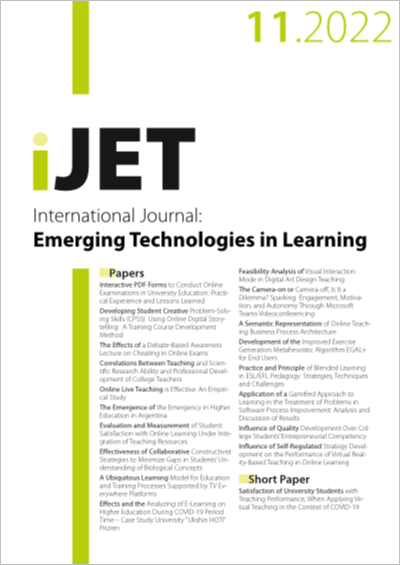The Camera-on or Camera-off, Is It a Dilemma? Sparking Engagement, Motivation, and Autonomy Through Microsoft Teams Videoconferencing
DOI:
https://doi.org/10.3991/ijet.v17i11.29061Keywords:
Microsoft Teams, videoconferencing, students’ engagement, students’ motivation, autonomyAbstract
A videoconferencing system to communicate synchronously is an indispensable tool for educators, teachers, students, parents, and administrators in online courses. One of the effective online learning platforms that can increase student engagement and motivation in online courses is Microsoft Teams. This research aimed to explore English as a Foreign Language (EFL) students’ views of enacting Microsoft Teams videoconferencing. This study employed a mixed-method design complemented by observation, open-ended questionnaires, as well as in-depth interviews for qualitative analysis in capturing and exploring their experience of synchronous learning using the Microsoft Teams in the post-pandemic. Furthermore, close-ended questionnaires were also distributed as quantitative data. The results revealed that Microsoft Teams helped the learners to be more involved in debates with both faculty and students as a result of their participation in discussion forums. They also gained a better comprehension and knowledge of language learning. It was clear that they were highly motivated and enjoyed the online course due to its ease of use and fun features, and they appreciated direct feedback in the synchronous online meeting. Thus, the learners with strong motivation can develop their learning autonomy. They can monitor and evaluate their self-progress in learning. Further research is highly recommended for exploiting Microsoft Teams to create innovations in a virtual classroom.
Downloads
Published
How to Cite
Issue
Section
License
Copyright (c) 2022 Ahmad Ridho Rojabi, Slamet Setiawan, Ahmad Munir, Oikurema Purwati, Widyastuti

This work is licensed under a Creative Commons Attribution 4.0 International License.


